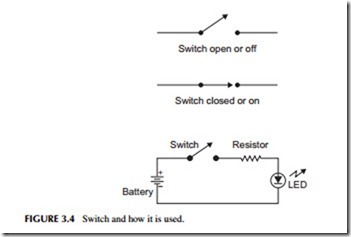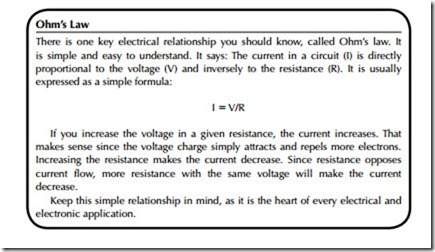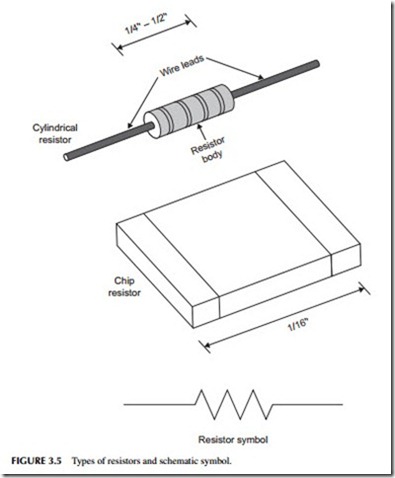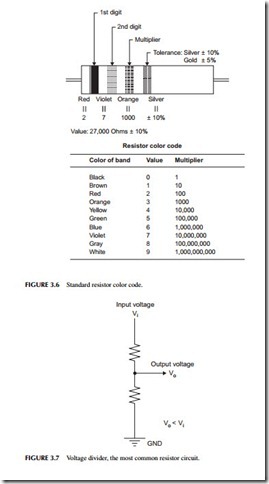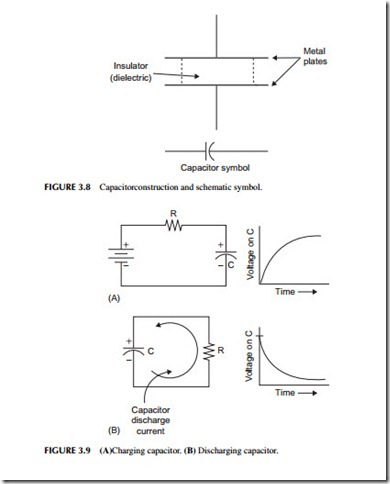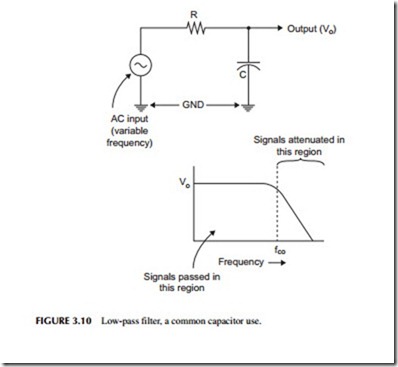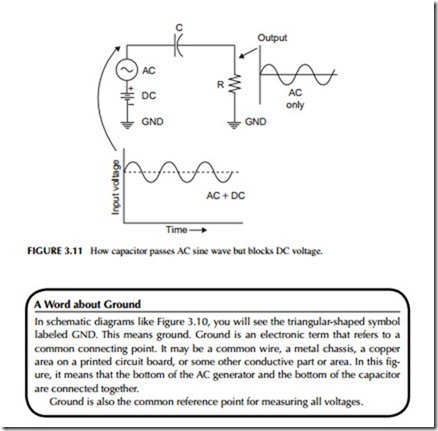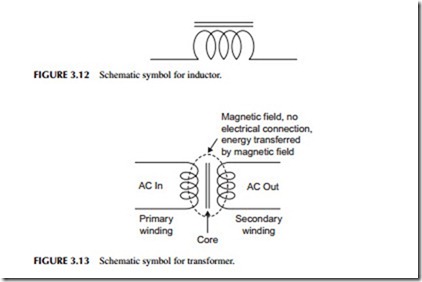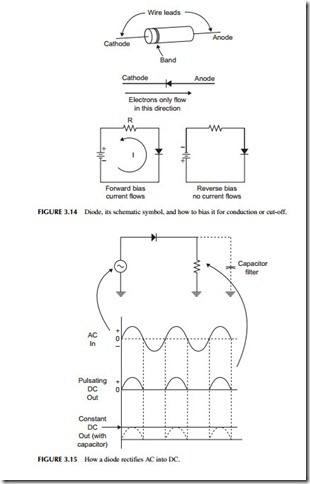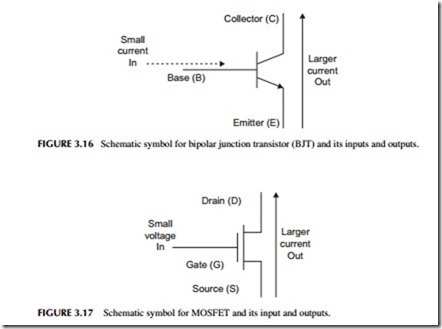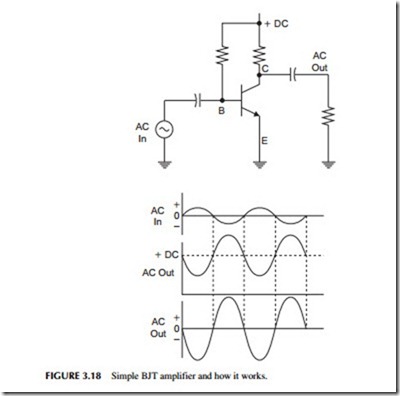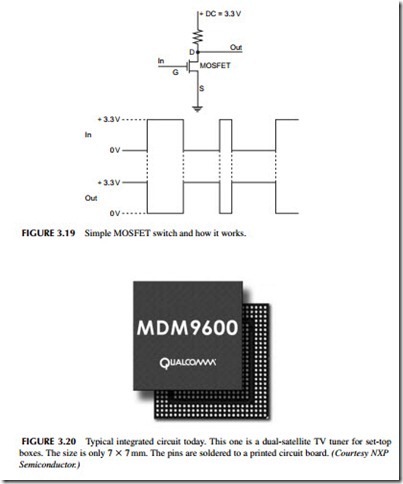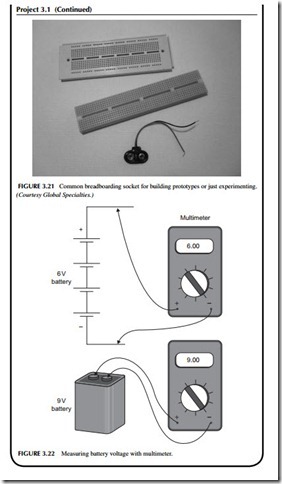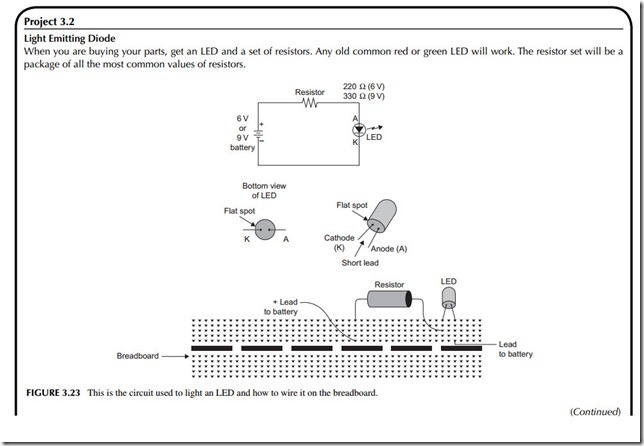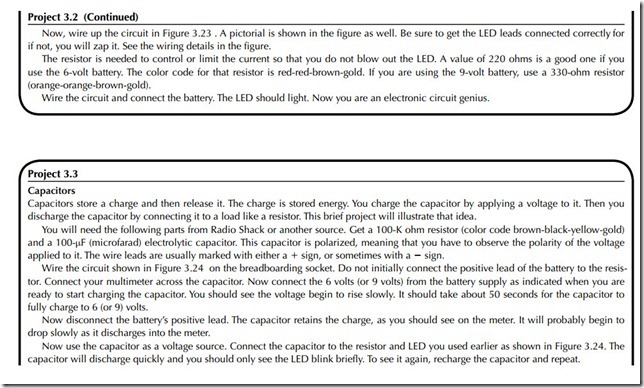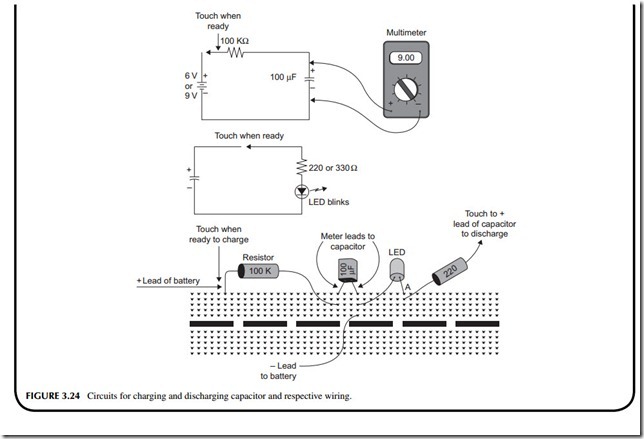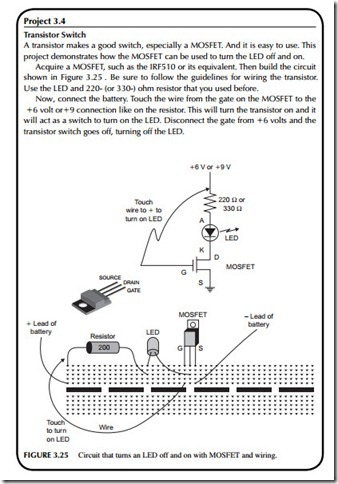ELECTRONIC COMPONENTS
Most systems today are collections of ICs wired together on printed circuit boards and packaged in a housing of some sort. The MP3 player/iPod in Figure 3.3 is a great example. Each block in that diagram is an IC. In the past, systems were made with PCBs and other assemblies, but the circuits were made with discrete components, individual resistors, capacitors, diodes, transistors, and even some ICs. You will still see these here and there in modern equipment; just remember that most circuits and equipment are just a batch of ICs.
Just so you won’t be ignorant of components, here is a nutshell introduction that should serve you well when learning electronics the system way. If you want to dig deeper, you can find many other books that will make your eyes glaze over with detail.
Switches
There is no simpler electrical component than a switch. It is just two (sometimes more) metal contacts and a mechanical device to open and close them. In one position the switch contacts are open and not touching so that no current will flow through them; the switch is “off.” Moving the switch lever, the contacts are made to touch making a path for current to flow; the switch is said to be “on.”
Figure 3.4 shows a switch in a circuit diagram called a schematic. This shows the switch connected to a battery and a light-emitting diode (LED) in a simple flashlight. The other component is a resistor to limit the current.
Today most resistors are made along with all the other circuitry in an IC. But discrete component resistors are also still fairly widely used. The most common ones are called chip resistors and look something like the one shown in Figure 3.5. They are small and you can just make them out when looking at a printed circuit board. Older but still used resistors are cylindrical like the one shown in Figure 3.5. The schematic symbol used to represent a resistor in a schematic diagram is shown in Figure 3.5. Color-coded resistors use a set of color bands with a special code to indicate their value (see Figure 3.6).
An example of a common resistor circuit is the voltage divider shown in Figure 3.7. It is used to attenuate a voltage or signal or make it lower. The two resistors of the voltage divider are connected in series. When current flows, a
voltage develops across the two resistors. The input voltage is divided between the two resistors according to their value. In any case, the output is taken from one of the resistors and it is lower in value than the input.
Capacitors
A capacitor is a device that stores an electrical charge. It is made up of two metallic plates separated by an insulator such as plastic or ceramic or even air (see Figure 3.8). The symbol for a capacitor in schematics is also shown.
The basic function of a capacitor is to be charged or discharged. You charge the capacitor by applying a voltage to it as shown in Figure 3.9A. The electrons pile
up on one plate making it negative and are pulled away from the other plate making it positive. It takes a finite amount of time for the capacitor to charge as deter- mined by the values of capacitance (C), stated in farads (F), and resistance (R). That time is called the time constant (T). In the charged state, the capacitor stores the voltage. The capacitor in its charged state is almost like a battery, as it can sup- ply DC voltage to a circuit or load.
The energy stored in the capacitor is used by discharging it into a load such as a resistor (see Figure 3.9B). The electrons then flow from the negative plate through the resistor to the positive plate. Current flows until the charge is dissipated. Again, it takes time for the discharge to occur.
When capacitors are used with AC signals, they offer opposition to current flow called capacitive reactance. It is like resistance in that it determines cur- rent flow, but it varies with the frequency of the AC and capacitor value.
Capacitors perform all sorts of functions in electronic circuits. They are used for filtering and they are used to pass AC but block DC. Figure 3.10 shows a low-pass filter comprised of a resistor and a capacitor. This is a frequency-sensitive circuit that passes AC signals below a specific frequency called the cut-off frequency (fco) and attenuates the frequencies above the cut- off. Figure 3.11 shows how a capacitor passes AC but blocks DC.
Inductors
Inductors are mainly just coils of wire. When current flows through them, they produce a magnetic field and induce a voltage in themselves. This is called self- induction. The induced voltage has an opposite polarity of the applied voltage. The result is that the induced voltage causes opposition to the current flow. We often use that characteristic to control current flow in AC circuits. Like the capacitor, the inductor is an opposition to AC called inductive reactance. Figure 3.12 shows the symbol of an inductor as used in schematic diagrams.
Transformers
A transformer is usually comprised of two coils or windings on a common core. The schematic symbol is shown in Figure 3.13. A voltage applied to one winding called the primary causes current to flow and a magnetic field to develop. This magnetic field spreads out and induces voltage in the other
winding called the secondary, thereby transferring electrical energy for one coil to another by way of the magnetic field. Transformers are used to step up or step down voltage levels of AC signals. They are also used for signal isolation as well as impedance matching.
Diodes
A diode is a semiconductor component that lets current flow through it in one direction but blocks current in the other direction depending on the polarity of the voltage applied to it. It acts like a polarity-sensitive switch. Figure 3.14 shows a typical diode, the diode schematic symbol, and how it is biased for current or no current.
Diodes are used mainly for rectification, the process of converting AC into DC. Figure 3.15 shows how a diode converts an AC sine wave into DC pulses. If you put a capacitor across the load resistor, it will charge up to the peak sine voltage and store it. The result is that the output is a near-constant DC value. Most electronic power supplies work like this.
Special diodes are made to emit light (LED), regulate voltage (zener diode), act as a variable capacitor (varactor), or perform as a switch (PIN diode).
Transistors
A transistor is a three-terminal semiconductor device that uses a small input signal to control a much larger output signal. One type of transistor is the bipolar junction transistor (BJT) shown in Figure 3.16 . A small current applied to the base element is used to control a larger current flowing from emitter to collector.
Another type of transistor is the metal oxide semiconductor-field-effect transistor (MOSFET). It too has three elements, as shown in Figure 3.17. A small voltage on the gate controls a larger current flowing from source to drain.
Transistors have two basic functions: amplification and switching. In amplification, the small input variation causes larger output current variation. The small input signal isn’t really made bigger, but the larger output variation has the same shape and characteristics, resulting in the same effect. The transistor simply varies the larger DC current from the supply and shapes it like the input.
Amplifiers
Figure 3.18 shows a simple BJT amplifier. The base resistor sets the base current turning the transistor on so that current flows from emitter to collector. Its output voltage is a DC value at about half the supply voltage. Now, if a small AC signal is applied through the capacitor as shown, the base current will vary. This will vary the collector current and the voltage across the col- lector resistor. A small variation in the base current produces a larger variation in the collector current. The output voltage is an enlarged version of the input, except that it is reversed in phase. We say that the output is 180 degrees out of phase with the input, called phase inversion. The output is a DC signal, but to convert it to AC we pass it through a capacitor to the load. All amplifiers generally work like this.
Switches
As a switch, the transistor output current is turned off or on by the smaller input current or voltage. A small input signal can switch a larger output cur- rent off and on. Switching transistors can switch very fast (in less than nanoseconds). Figure 3.19 shows a MOSFET switch. If the input voltage on the gate is zero, the MOSFET does not conduct. It acts like an open or off switch. The output then is just the supply voltage (+V) as seen through the resistor.
Now, if we apply voltage to the gate above a certain threshold level, the MOSFET will conduct. It acts like a closed or on switch so current flows in the resistor. The output is a very small value near zero. Figure 3.19 also shows what the inputs and outputs look like with a square wave applied.
Integrated Circuits
An IC is also called a chip. It is a complete circuit made on a single chip of silicon. All the components are made at the same time and interconnected to form an amplifier, microcomputer, memory, oscillator, radio transceiver, or
whatever the function. The IC is then connected to DC power and it works. All you do is apply the inputs, and new outputs are produced according to what the IC function is. Most circuits today are ICs.
There are all sizes and types of ICs. There are linear circuits for analog sig- nals, digital circuits for binary signals, and mixed signal IC for both analog and digital signals. There are small ICs that are just an amplifier or logic circuit. Then there are even larger circuits like a computer memory or a microprocessor that is the heart of every computer. Finally, there are complete systems on a chip (SoC). Each year, it is possible to make the components on a silicon chip smaller so you can put more on a chip economically. That is why we have iPods, cell phones, and other really small devices that in the past would have been huge pieces of equipment. Figure 3.20 is representative of ICs today.
Light Emitting Diode
When you are buying your parts, get an LED and a set of resistors. Any old common red or green LED will work. The resistor set will be a package of all the most common values of resistors.
Transistor Switch
A transistor makes a good switch, especially a MOSFET. And it is easy to use. This project demonstrates how the MOSFET can be used to turn the LED off and on.
Acquire a MOSFET, such as the IRF510 or its equivalent. Then build the circuit shown in Figure 3.25 . Be sure to follow the guidelines for wiring the transistor. Use the LED and 220- (or 330-) ohm resistor that you used before.
Now, connect the battery. Touch the wire from the gate on the MOSFET to the +6 volt or+9 connection like on the resistor. This will turn the transistor on and it will act as a switch to turn on the LED. Disconnect the gate from +6 volts and the transistor switch goes off, turning off the LED.
